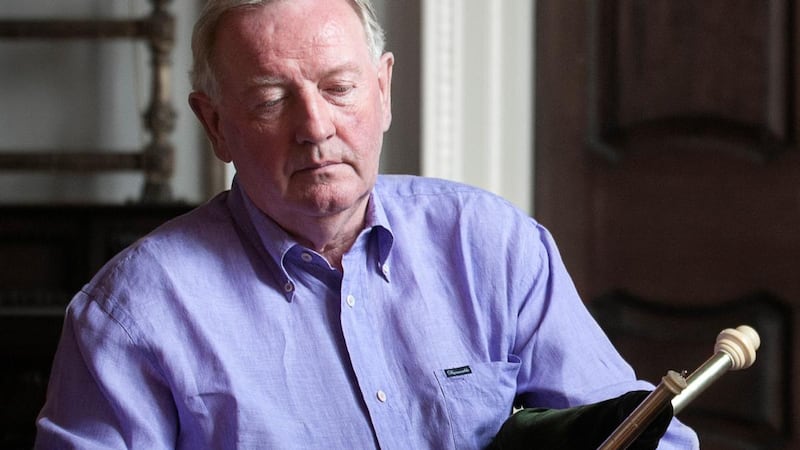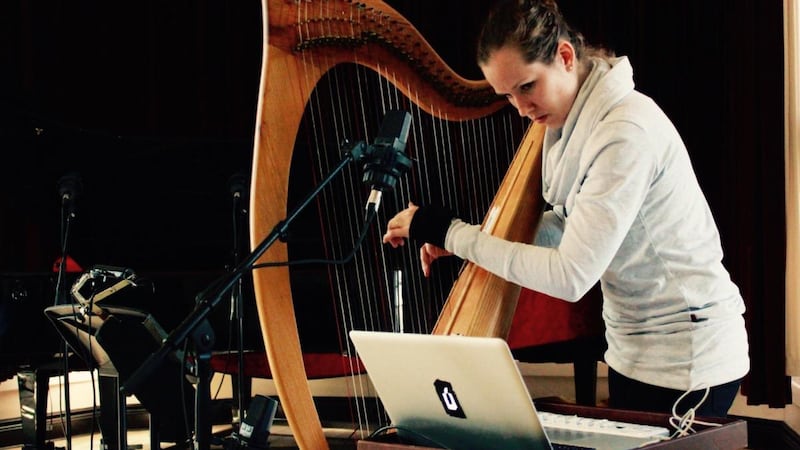A strong grounding in music from her family and a lifelong love of science. Both were formative influences on harpist Úna Monaghan, the recipient of the National Concert Hall and Arts Council's inaugural Liam O'Flynn Award.
Piper Liam O'Flynn's passing last year was an incalculable loss to the traditional music world, but his legacy is immense. He was an artist of enormous integrity who valued the art of reflection, and lived it in his music. The National Concert Hall and the Arts Council's joint sponsorship of an award in his memory is a fitting response to his passing. It celebrates his rich artistic contribution by offering Monaghan opportunities to work in a stimulating environment, to collaborate with artists of her own choosing and to engage with audiences on projects of her own making.
The Irish Times intercepts Monaghan via Skype, as she prepares to fly from Norway to China, where she’s engaged in musical projects as diverse as sound engineering the performance of newly composed work by Jennifer Walshe (in Norway) and creating a sound installation and delivering a speech to mark International Women’s Day (in China).
“Liam played with so many people, but he was also a soloist in many ways,” Úna offers, taking her time to reflect on her motivations for applying for this award, based on a project which she felt was a perfect fit for the award’s objectives. “The work that I had in mind was a programme concentrating on traditional musicians as solo instrumentalists. I had also done sound a few times for Liam and somehow I felt that there was a bit of a connection there too, with what I was trying to do.”
Science and art
With a degree in astrophysics from Cambridge and a masters in sonic arts, this Belfast harpist has steered an intriguing course through the worlds of science and arts. Her PhD research was a bridge to her current body of work that straddles electroacoustic composition for harp and sensors, live performance, academic research and sound engineering.
“My doctoral research was on new technologies and experimental practices in Irish traditional music: improvisation, experimentalism and electronics,” Úna explains. “And more recently I’ve been working on a two-year fellowship that explores the intersections between Irish traditional music and those practices, and what this means creatively, culturally, politically and socially.”
The Liam O’Flynn Award couldn’t have come at a better time, Úna enthuses. As an artist, the challenge is always there to find ways to juggle one’s own creative projects with the mundane realities of paying the bills. This can sometimes lead to artists attempting to shoehorn their ideas into shapes which fit the demands of a particular funding opportunity. In this instance though, Monaghan felt an immediate synergy between a project she had already conceived and the objectives of the Liam O’Flynn Award.

“I think every artist has the work that they want to do in mind,” she offers, keen to acknowledge the constant juggling that characterises the artistic process, “and given what it takes to actually fund that work, you’re always looking about, with a bank of ideas in your head, which you keep until you see something that will enable that work. Because you’re always doing half the work that comes to you, and half the work that you want to do. So I have ideas, and every so often a funding opportunity will come up that might enable a particular idea to happen.
Suite of compositions
“As soon as I heard about this award, I felt that my idea fitted with it,” she continues. “I’m working on a suite of compositions for solo traditional musician and electronics. There will be 12 of them in total. I’ve spent a number of years working on harp and electronics in my own music and I began to think about other people who I could write for in the same way. I wanted to have a range of musicians and a range of instruments: four are written or in progress and with this award I’ll be able to do two more.”
To date, Monaghan has composed for and collaborated with fiddle player Paddy Glackin, singer Pauline Scanlon and pianist Saileog Ní Cheannabháin, melding her original electronics with their organic playing and singing. This electro acoustic composition work is what fires her creatively.
“I love it,” she enthuses. “You work on top of the work of everyone else who came before. I consider the composition to be in three parts: the idea – that’s the musical work, the performance of it and the technology. They all have to proceed from day one in tandem. I work with wireless motion sensors and then musically I have to see how that makes sense with the piece I want to make.”
A central tenet of Monaghan’s work is the need to remain open to what will happen in any given performance. Sensors, worn by her on her hand, will respond differently each time, depending on factors such as her own hand position and the ways in which she chooses to manipulate her computer software in response to the music she or other musicians are playing.
“That is the essence of traditional music as well,” Úna observes. “I’m not really interested in having something that needs to be correct or exact every time. I don’t have notation and there’s always improvisation in my pieces. There’s always some sort of randomness within the computer, and I think it’s really important to keep these performances as live as possible.”
Listener relished
That embrace of improvisation allows Monaghan to be in the moment as she performs. The serendipity of the encounter between performer and audience member or listener is something that she relishes too, as the artist can’t know what the listener is bringing to a given performance, so there is no way of knowing what they might take away, she believes.

“The listener is huge to me,” says Monaghan, keen to explore that circular relationship that is an inevitable central part of any performance. “The listener isn’t just someone to play to. At the end of my performances, I would love to sit down and have a chat with everyone in the audience to ask: What did you think of that? What did that make you think of? Why did that matter to you? It’s a really big thing in experimental music: the piece is finished by the listener. And that is no less true of traditional music than it is of any other music.”
Monaghan is a renaissance artist with many facets to her work. But she’s quick to underline the realities of the creative existence too.
“I work four jobs: as a composer, a sound engineer, in academia and as a performer,” she reflects, with an unvarnished honesty that cuts to the core of everything she undertakes. “We can talk about being open as artists, but we also need to acknowledge that it’s a very unstable and a very precarious world to be in. I would love to be able to pay my way doing all those things that really interest me and that allow me to connect with people. I just want to be able to make all that work.”
Liam O’Flynn Award: Celebrating traditional music and innovation
The Liam O’Flynn Award is a joint initiative of the Arts Council and the National Concert Hall. A virtuoso piper who pushed the boundaries of both piping and its place in traditional music, Liam O’Flynn played a crucial role in promoting traditional music. As a founding member of Planxty as well as in his collaboration with Shaun Davey on The Brendan Voyage, his musical explorations were groundbreaking.
In his memory, the Liam O’Flynn Award celebrates the role of the individual creative traditional artist in the creation of new works, the inception of unique artistic collaborations and innovations, and the transmission of traditional arts for future generations. The purpose of the award is to provide the recipient with a period of artistic reflection, inspiration and creation in residence at the National Concert Hall, and to enhance appreciation, knowledge and enjoyment of the traditional arts.
unamonaghan.com










